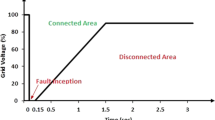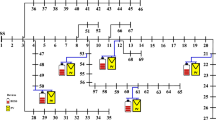Abstract
Load flow analysis is the initial and essential step for any power system computation. It is required for choosing better options for power system expansion to meet with ever increasing load demand. Implementation of Flexible AC Transmission System (FACTS) device like STATCOM, in the load flow, which is having fast and very flexible control, is one of the important tasks for power system researchers. This paper presents a simple and systematic approach for steady state power flow calculations with FACTS controller, static synchronous compensator (STATCOM) using command line usage of MATLAB tool-power system analysis toolbox (PSAT). The complexity of MATLAB language programming increases due to incorporation of STATCOM in an existing Newton–Raphson load flow algorithm. Thus, the main contribution of this paper is to show how command line usage of user friendly MATLAB tool, PSAT, can extensively be used for quicker and wider interpretation of the results of load flow with STATCOM. The novelty of this paper lies in the method of applying the load increase pattern, where the active and reactive loads have been changed simultaneously at all the load buses under consideration for creating stressed conditions for load flow analysis with STATCOM. The performance have been evaluated on many standard IEEE test systems and the results for standard IEEE-30 bus system, IEEE-57 bus system, and IEEE-118 bus system are presented.





Similar content being viewed by others
References
S. Arabi, P. Kundur, A versatile FACTS device model for power flow and stability simulations. IEEE Trans. Power Syst. 11(4), 1944–1950 (1996)
H. Sadat, Power System Analysis (Tata Mc-Graw Hill, New York, 2012)
N.G. Hingorani, L. Gyugyi, Understanding FACTS: Concepts and Technology of Flexible AC Transmission Systems (IEEE-Press, New York, 2000)
E. Acha, C.R. Fuerte-Esquivel, H. Ambriz-Pérez, C. Angeles-Camacho, FACTS: Modeling and Simulation in Power Networks (Wiley, West Sussex, 2004)
X.-P. Zhang, C. Rehtanz, B. Pal, Flexible AC Transmission Systems: Modelling and Control (Springer, Berlin, 2006)
T.J. Hammonsa, S.K. Lim, Flexible AC transmission systems (FACTS). Electr. Mach. Power Syst. 25, 73–85 (1995)
C.W. Taylor, Power System Voltage Stability (Mc-Graw Hill, New York, 1993)
T. Van Cutsem, C. Vournas, Voltage Stability of Electric Power Systems (Kluwer Academic Publishers, Massachusetts, 1998)
D.J. Gotham, G.T. Heydt, Power flow control and power flow studies for systems with FACTS devices. IEEE Trans. Power Syst. 13(1), 60–65 (1998)
D.J. Gotham, G.T. Heydt, Power flow control in systems with FACTS devices. Electr. Mach. Power Syst. 26, 951–962 (1998)
E. Acha, B. Kazemtabrizi, A new STATCOM model for power flows using the Newton–Raphson method. IEEE Trans. Power Syst. 28, 2455–2465 (2013)
Z. Yang, C. Shen, M.L. Crow, L. Zhang, An improved STATCOM model for power flow analysis. IEEE Trans. Power Syst. 2, 1121–1126 (2000)
G.M. Gilbert, D.E. Bouchard, A.Y. Chikhani, A comparison of load flow analysis using DISTFLOW, Gauss-Seidel, and optimal load flow algorithms. IEEE Can. Conf. Electr. Comput. Eng. 2, 850–853 (1998)
M. Tarafdar Hagh, M.B.B. Sharifian, S. Galvani, Impact of SSSC and STATCOM on power system predictability. Electr. Power Energy Syst. 56, 159–167 (2013)
R. Srinivasa Rao, V. Srinivasa Rao, A generalized approach for determination of optimal location and performance analysis of FACTS devices. Electr. Power Energy Syst. 73, 711–724 (2015)
P. Arboleya, C. Gonzalez-Moran, M. Coto, Modeling FACTS for power flow purposes: a common framework. Electr. Power Energy Syst. 63, 293–301 (2014)
S. Kamela, F. Juradob, Power flow analysis with easy modelling of interline power flow controller. Electr. Power Syst. Res. 108, 234–244 (2013)
Q. Tong, Analysis and comparison of algorithm and model for power flow calculation with FACTS devices, in IEEE advanced information technology, electronic and automation control conference (IAEAC), pp. 1024–1028 (2015)
T. Datta, P. Nagendra, S. Halder nee Dey, S. Paul, Voltage stability assessment of a power system incorporating FACTS in equivalent mode. J. Electr. Syst. 9(4), 440–452 (2013)
B.S. Pali, S. Bhowmick, N. Kumar, Power flow models of static VAR compensator and static synchronous compensator, in IEEE fifth power India conference, pp. 1–5 (2012)
J.C. Das, Application of STATCOM to an industrial distribution system connected to a weak utility system. IEEE Trans. Ind. Appl. 52(6), 1–12 (2016)
A. Keyhani, A. Abur, S. Hao, Evaluation of power flow techniques for personal computers. IEEE Trans. Power Syst. 4(2), 817–826 (1989)
F. Milano, An open source power system analysis toolbox. IEEE Trans. Power Syst. 20(3), 1199–1206 (2005)
L. Vanfretti, F. Milano, Application of the PSAT, an Open Source Software, For Educational and Research Purposes, in IEEE Power Engineering Society General Meeting, pp. 1–7 (2007)
F. Milano, Power system analysis toolbox documentation for PSAT version 2.1.8. http://thunderbox.uwaterloo.ca/~fmilano (2006)
Author information
Authors and Affiliations
Corresponding author
Rights and permissions
About this article
Cite this article
Telang, A.S., Bedekar, P.P. Application of PSAT to Load Flow Analysis with STATCOM under Load Increase Scenario and Line Contingencies. J. Inst. Eng. India Ser. B 99, 17–23 (2018). https://doi.org/10.1007/s40031-017-0292-6
Received:
Accepted:
Published:
Issue Date:
DOI: https://doi.org/10.1007/s40031-017-0292-6




